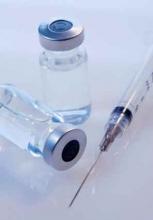The high-dose version of the trivalent inactivated influenza vaccine induced higher antibody responses and provided significantly improved protection against the disease in patients aged 65 years and older participating in an industry-sponsored phase III-IV randomized, controlled trial, which was reported online Aug. 14 in the New England Journal of Medicine.
The standard-dose vaccine is less effective in older adults, with an absolute efficacy of approximately 50%, than in adults younger than age 65 years. In comparison, given the findings of this large clinical trial, "the absolute efficacy of the high-dose vaccine would be estimated at 62%, a level of protection similar to that seen with standard-dose vaccines in younger adults," said Dr. Carlos A. DiazGranados of Sanofi Pasteur, Swiftwater, Pa., and his associates.
The high-dose trivalent inactivated vaccine, IIV3-HD (Fluzone High Dose), was licensed for use in the United States in 2009, with a requirement to show clinical benefits. This trial was designed to demonstrate those benefits by comparing its efficacy against that of the standard-dose vaccine (Fluzone) in the elderly.
A total of 31,989 adults aged 65 years and older participated in the double-blind trial at 126 medical centers in the United States and Canada during a 20-month period (two flu seasons). They were randomly assigned to receive a single intramuscular dose of either the standard-dose vaccine, which contains 15 mcg of hemagglutinin/strain (15,998 patients), or the high-dose vaccine, which contains 60 mcg of hemagglutinin/strain (15,991 patients).
Blood samples collected from a subset of approximately one-third of the study participants showed that antibody levels for all three influenza strains were significantly higher in members of the high-dose group than in those in the low-dose group at 28 days after vaccination.
The primary endpoint of the trial was the development of influenzalike illness, together with laboratory-confirmed influenza caused by any viral type, at least 14 days after vaccination. This occurred in 301 patients (1.9%) in the standard-dose group, compared with 228 patients (1.4%) in the high-dose group. Therefore, the efficacy of IIV3-HD relative to the standard-dose vaccine was 24.2%, which met the study criterion for superiority, the researchers stated.
This level of efficacy "indicates that about one-quarter of all breakthrough influenza illnesses could be prevented if IIV3-HD were used" instead of the standard-dose vaccine in this age group, Dr. DiazGranados and his associates said (N. Engl. J. Med. 2014 Aug. 14 [doi:10.1056/NEJMoa1315727]).
In addition, rates of pneumonia, cardiorespiratory conditions, hospitalizations, nonroutine medical office visits, and medication use were lower in the high-dose than in the low-dose group. This suggests that the clinical benefits of IIV3-HD will translate into public health benefits, they said.
The rate of serious adverse events was slightly higher with the standard-dose vaccine (9.0%) than with the high-dose vaccine (8.3%). The rate of withdrawal from the study because of adverse events was identical between the two groups at 0.6%, and none of those events were considered to be related to vaccination.
Three patients who received the high-dose vaccine had serious adverse events considered to be related to vaccination: one developed cranial-nerve VI palsy the day after the injection; one developed hypovolemic shock from diarrhea that started the day after the injection; and one developed acute disseminated encephalomyelitis that began 117 days after vaccination. All of these events resolved over time.
This trial was funded by Sanofi-Pasteur, maker of IIV3-HD, which also was involved in study design and monitoring, data management, and statistical analysis.


